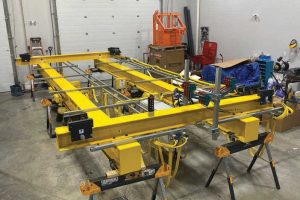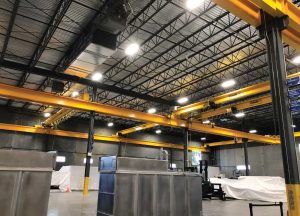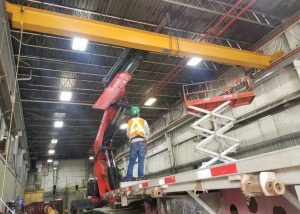The Canadian hoist market is holding its ground in spite of a broader slowdown tied to economic, political, and legal factors. Mike Straus reports from Canada’s Pacific Northwest.
If there is one common theme that emerges from western Canadian history and culture, one essential story of Canada in general and the Pacific Northwest and Prairies in particular, it is the story of hardiness and determination in the face of a harsh and unforgiving environment.
So, too, does the western Canadian hoist market persist despite economic headwinds, political challenges, and significant changes in market demands.
Bryan Wescott is the owner of Overhead Crane Solutions, a parts and service provider based in Nisku, Alberta. Wescott says that the Alberta hoist market is in the middle of a slowdown. Although there does appear to be significant market activity in certain areas, Wescott says it is isolated and benefits only a select few companies.
According to the Canadian Association of Petroleum Producers, the oil industry accounts for 30% of all economic activity in Alberta. The province of Alberta is landlocked and depends on British Columbia to get oil products to market. Thus, any delay regarding the pipeline expansion is problematic for Alberta’s economy as a whole.
“We noticed a big downturn after the court struck down the approval of the Trans Mountain pipeline,” Johnson says. “We had our eyes set on expanding into a new region of Canada, but as soon as that decision was announced, everything changed overnight.”
The Trans Mountain pipeline is still facing legal challenges. In September 2019, the British Columbia Court of Appeal ordered the provincial government to conduct a new environmental assessment, ruling that the previous environmental assessment is invalid because it was based on the federal government’s original approval report that the Federal Court of Appeal quashed. And in December 2019, First Nations groups filed a new lawsuit against the Canadian Government in the Federal Court of Appeal. This new suit alleges that the second round of indigenous consultations fell short of what the Canadian Constitution requires, and therefore the government’s second approval of the pipeline is invalid. The environmental assessment is ongoing, and while the Federal Court of Appeal dismissed the First Nations lawsuit on February 4, the First Nations are expected to take their case to the Supreme Court of Canada. The First Nations have until April 4 to file an appeal with the Supreme Court.
The pipeline did, however, clear one important legal hurdle on January 16, 2020, when the Supreme Court of Canada dismissed an appeal brought by the Province of British Columbia. Lawyers for the provincial government sought to affirm the province’s right to regulate the kinds of oil products that flow through the pipeline, and aimed to overturn a lower court decision to the contrary. However, the Supreme Court of Canada upheld the previous court decision that regulating the contents of a pipeline falls under federal, not provincial, jurisdiction.
Capitalising on the unexpected
But the pipeline is just one obstacle companies must manoeuvre around. Michael Young is the president of CraneEx, a parts, service, and training company based in Edmonton, Alberta. Young says that fluctuating fuel prices, the federal carbon tax, and unpredictability in international trade are making it difficult to calculate shipping costs.
“The market is changing so quickly that we can’t predict what our costs will be more than two days out,” Young says. “We’re always guessing on how much shipping will cost. The steel and aluminium tariffs coming up from the United States were a disaster for us.
Things change so fast that we’re asking a lot more questions than we should have to, which means it’s getting harder and harder to do business.”
While the oil market is slumping, other industries appear to be doing well. Paper products are in high demand, and CraneEx has done work with several plants that are shipping pulp and paper products overseas.
“We’re selling hoists for mining in Saskatchewan, and that seems to be doing well,” Young notes. “And in Grande Prairie, Alberta, there’s a bit of a natural gas boom happening. Some of the natural gas pipelines around Edmonton are being moved around so that they’ll eventually connect to the natural gas reserve in Vancouver.”
Western Canadian companies are also eagerly investing into new technology, especially safety equipment. The majority of technological upgrades involve a move from wired to wireless pendants.
“There are still a lot of wired systems out there,” Johnson says, “but when people have problems with pendant wires, we find that instead of replacing the wire, they upgrade to a wireless system.”
Wescott says that variable frequency drive hoists are currently in high demand. While service and inspection work tends to be a more active market than manufacturing, there is still demand for fabrication work.
Prioritising maintenance; Bread-and-Butter Projects
Companies in the eastern Prairies are also seeing steady activity. Mark Logan is the sales and marketing manager for Acculift, a distributor and service provider that designs lift and hoist equipment. Based in Winnipeg, Manitoba, Acculift serves clients across central/western Canada from northern Ontario to British Columbia.
Acculift’s scope of work ranges from a manual-movement workstation crane to a 20t bridge crane.


